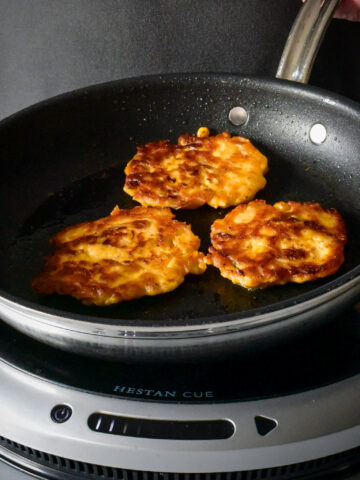Croissant Eggs Benedict. Indulge in the luxurious combination of perfectly poached eggs, savoury sliced ham, and velvety hollandaise sauce, all nestled within a buttery croissant.

Although the origins of Eggs Benedict are a bit hazy, the dish is believed to have been created in New York City in the late 1800s. The story goes that Lemuel Benedict, a stockbroker, walked into the Waldorf Hotel one morning and requested a dish that would cure his hangover.

So if you find yourself having had a few too many green beers this St. Patrick’s Day weekend, check out our recipe for Eggs Benedict. It might be exactly the cure for what “ales” you. ☘️🍻
Jump to:
Ingredients

- Small croissant rolls
- Ham slices
- Large eggs
- Vinegar
For the Hollandaise Sauce
- Large egg yolks
- Lemon juice
- Mustard
- Unsalted butter
- Cayenne pepper
- Salt to taste
Garnish
- Fresh chopped chives, (optional)
- Fresh cracked black pepper
See recipe card for quantities.
Instructions
Hollandaise Sauce
Heat an inch of water in a pot that holds a stainless-steel mixing bowl without the bowl touching the water. Bring the water to a simmer then turn down the heat to keep the water barely simmering.
Place the butter in a small saucepan over a low heat, so it gently melts but does not burn. Once melted, turn off the heat.

In the mixing bowl, vigorously whisk together the egg yolks, lemon juice and mustard until frothy and thickened.

Place the bowl over the pot and continue to whisk rapidly. Drizzle in the melted butter a little at a time while whisking constantly, until the sauce is smooth and creamy, about 8 to 10 minutes. Be careful not to let the mixture get too hot, or the eggs may scramble. If required, remove the bowl from the heat and continue to whisk, then return to the heat.


Season the hollandaise sauce with cayenne pepper and salt. Cover the bowl with plastic wrap to keep warm until ready to serve.
Preheat the oven to the broiler.
Poach the Eggs
Fill a 3.5-Qt sauté pan (or wide shallow pan) with 2-3 inches water and bring it to a light simmer over a medium heat.
Crack the eggs into small bowls or ramekins. Carefully slide each egg into the water and poach for about 2 ½ to 3 ½ minutes, or until the whites are set but the yolks are still soft. Cooking time will vary based on the size of the eggs if they are cold from the fridge or room temperature and how hot the water is.

Use a slotted spoon to help shape and turn your eggs over to cook evenly.
Carefully remove the poached eggs with the slotted spoon and drain on a paper towel lined tray.
Depending on the size of your pan you can poach your eggs in batches, so they are not overcrowded and keep them in warm water until ready to serve (not hot water or they will continue to cook).
While the eggs are poaching, toast the croissants.
Toast the Croissants
Toast the cut side croissant rolls until golden brown and crispy.
Assemble & Enjoy!
To assemble, place three slices of ham on the bottom croissant half. Carefully place two poached eggs on top of the ham slices.
Spoon hollandaise sauce generously over the eggs. Serve with the top half of the croissant and garnish with fresh chives, if desired.


Serve immediately and enjoy.
Watch how these Croissant Eggs Benedict were made here.
Pro Tips for Making Hollandaise Sauce
- Use fresh eggs: Fresh eggs will give your hollandaise sauce a rich flavour and creamy texture.
- Keep ingredients at room temperature: Make sure your eggs and butter are at room temperature before starting to prevent the sauce from curdling.
- Whisk constantly: Whisk the egg yolks vigorously while adding the melted butter to ensure a smooth and creamy sauce.
- Control the heat: Use low to medium heat to prevent the eggs from cooking too quickly or scrambling. If the sauce gets too hot, remove it from the heat briefly to cool down.
- Add butter slowly: Pour the melted butter into the egg yolks in a slow, steady stream while whisking constantly. This helps emulsify the sauce and create a smooth consistency.
- Use a double boiler: Place the bowl with the egg yolks over a pot of simmering water (double boiler) to gently heat and cook the sauce. This method helps prevent overheating and curdling.
- Adjust seasoning: Season the hollandaise sauce with salt, and a pinch of cayenne pepper to taste.
- Strain if needed: If your hollandaise sauce has any lumps or bits of cooked egg, you can strain it through a fine-mesh sieve to achieve a silky-smooth texture.
- Serve immediately: Hollandaise sauce is best served fresh and warm. If you need to keep it warm before serving, place the bowl over a pot of warm water or use a thermos to hold the sauce.
- Practice makes perfect: Making hollandaise sauce can take some practice and patience, so do not get discouraged if it does not turn out perfectly the first time.
Pro Tips for Poaching Eggs
- Fresh eggs: Use the freshest eggs possible for poaching. Fresh eggs have firmer whites, which will hold their shape better during cooking.
- Vinegar in the water: Add 2 teaspoons of vinegar (or white or apple cider vinegar) to the simmering water. The acidity helps the egg whites coagulate faster, resulting in neater poached eggs.
- Use a shallow pan: Use a wide and shallow pan filled with about 2 inches of water. This provides enough room for the eggs to spread out and cook evenly.
- Bring water to a gentle simmer: Bring the water to a gentle simmer over medium heat. Avoid boiling the water vigorously, as it can break up the delicate egg whites.
- Create a whirlpool: Before adding the eggs, use a spoon or whisk to create a gentle whirlpool in the water. This swirling motion helps the egg whites wrap around the yolk for a more uniform shape.
- Crack eggs into a ramekin: Crack each egg into a small bowl or ramekin before gently sliding it into the simmering water. This prevents the egg from breaking apart or getting shell fragments into the water.
- Poach eggs in batches: Depending on the size of your pan, poach eggs in batches to avoid overcrowding. This ensures that each egg has enough space to cook properly.
- Monitor cooking time: Poach the eggs for about 2 ½ to 3 ½ minutes for a runny yolk or longer for a firmer yolk. Keep an eye on the eggs to avoid overcooking.
- Remove with a slotted spoon: Once the eggs are cooked to your desired doneness, carefully remove them from the water using a slotted spoon. Gently blot them with a paper towel to remove any excess water.
- Trim any excess whites: If necessary, use a sharp knife or kitchen shears to trim any wispy or excess egg whites before serving.
Equipment Used
Prepared using the Hestan Culinary Provisions Stainless Steel Mixing Bowls, the OvenBond Tri-ply Sheet Pan and the NanoBond Butter Warmer, 1.5-Qt Saucepan and 3.5-Qt Sauté Pan. Cooked on the Hestan Home Dual Fuel Range. Proud Hestan Ambassador. Opinions in this post are always my own!
Leave a Comment
If you get the chance to try this Croissant Eggs Benedict recipe please drop back and leave us a comment and rating here. We would love to know what you think! Thanks Elaine & James 🙂

Croissant Eggs Benedict
Ingredients
- 4 small croissant rolls halved
- 12 slices of ham
- 8 large eggs
- 2 teaspoons vinegar
For the Hollandaise Sauce:
- 4 large egg yolks
- 1 tablespoon lemon juice freshly squeezed
- 1 teaspoon mustard
- ½ cup unsalted butter
- ⅛ teaspoon of cayenne pepper
- ⅛ teaspoon salt to taste
Garnish
- Fresh chopped chives (optional)
- Fresh cracked black pepper
Instructions
Hollandaise Sauce
- Heat an inch of water in a pot that holds a stainless-steel mixing bowl without the bowl touching the water. Bring the water to a simmer then turn down the heat to keep the water barely simmering.
- Place the butter in a small saucepan over a low heat, so it gently melts but does not burn. Once melted, turn off the heat.
- In the mixing bowl, vigorously whisk together the egg yolks, lemon juice and mustard until frothy and thickened.
- Place the bowl over the pot and continue to whisk rapidly. Drizzle in the melted butter a little at a time while whisking constantly, until the sauce is smooth and creamy, about 8 to 10 minutes. Be careful not to let the mixture get too hot, or the eggs may scramble. If required, remove the bowl from the heat and continue to whisk, then return to the heat.
- Season the hollandaise sauce with cayenne pepper and salt. Cover the bowl with plastic wrap to keep warm until ready to serve.
- Preheat the oven to the broiler.
Poach the Eggs
- Fill a 3.5-Qt sauté pan (or wide shallow pan) with 2-3 inches water and bring it to a light simmer over a medium heat.
- Crack the eggs into small bowls or ramekins. Carefully slide each egg into the water and poach for about 2 ½ to 3 ½ minutes, or until the whites are set but the yolks are still soft. Cooking time will vary based on the size of the eggs if they are cold from the fridge or room temperature and how hot the water is.
- Use a slotted spoon to help shape and turn your eggs over to cook evenly.
- Carefully remove the poached eggs with the slotted spoon and drain on a paper towel lined tray.
- Depending on the size of your pan you can poach your eggs in batches, so they are not overcrowded and keep them in warm water until ready to serve (not hot water or they will continue to cook).
- While the eggs are poaching, toast the croissants.
Toast the Croissants
- Toast the cut side croissant rolls until golden brown and crispy.
Assemble & Enjoy
- To assemble, place three slices of ham on the bottom croissant half. Carefully place two poached eggs on top of the ham slices.
- Spoon hollandaise sauce generously over the eggs. Serve with the top half of the croissant and garnish with fresh chives, if desired.
- Serve immediately and enjoy.
- Please take 5 seconds to rate this recipe below. We would greatly appreciate it!
Video
Notes
- Use fresh eggs: Fresh eggs will give your hollandaise sauce a rich flavour and creamy texture.
- Keep ingredients at room temperature: Make sure your eggs and butter are at room temperature before starting to prevent the sauce from curdling.
- Whisk constantly: Whisk the egg yolks vigorously while adding the melted butter to ensure a smooth and creamy sauce.
- Control the heat: Use low to medium heat to prevent the eggs from cooking too quickly or scrambling. If the sauce gets too hot, remove it from the heat briefly to cool down.
- Add butter slowly: Pour the melted butter into the egg yolks in a slow, steady stream while whisking constantly. This helps emulsify the sauce and create a smooth consistency.
- Use a double boiler: Place the bowl with the egg yolks over a pot of simmering water (double boiler) to gently heat and cook the sauce. This method helps prevent overheating and curdling.
- Adjust seasoning: Season the hollandaise sauce with salt, and a pinch of cayenne pepper to taste.
- Strain if needed: If your hollandaise sauce has any lumps or bits of cooked egg, you can strain it through a fine-mesh sieve to achieve a silky-smooth texture.
- Serve immediately: Hollandaise sauce is best served fresh and warm. If you need to keep it warm before serving, place the bowl over a pot of warm water or use a thermos to hold the sauce.
- Practice makes perfect: Making hollandaise sauce can take some practice and patience, so do not get discouraged if it does not turn out perfectly the first time.
- Fresh eggs: Use the freshest eggs possible for poaching. Fresh eggs have firmer whites, which will hold their shape better during cooking.
- Vinegar in the water: Add 2 teaspoons of vinegar (or white or apple cider vinegar) to the simmering water. The acidity helps the egg whites coagulate faster, resulting in neater poached eggs.
- Use a shallow pan: Use a wide and shallow pan filled with about 2 inches of water. This provides enough room for the eggs to spread out and cook evenly.
- Bring water to a gentle simmer: Bring the water to a gentle simmer over medium heat. Avoid boiling the water vigorously, as it can break up the delicate egg whites.
- Create a whirlpool: Before adding the eggs, use a spoon or whisk to create a gentle whirlpool in the water. This swirling motion helps the egg whites wrap around the yolk for a more uniform shape.
- Crack eggs into a ramekin: Crack each egg into a small bowl or ramekin before gently sliding it into the simmering water. This prevents the egg from breaking apart or getting shell fragments into the water.
- Poach eggs in batches: Depending on the size of your pan, poach eggs in batches to avoid overcrowding. This ensures that each egg has enough space to cook properly.
- Monitor cooking time: Poach the eggs for about 2 ½ to 3 ½ minutes for a runny yolk or longer for a firmer yolk. Keep an eye on the eggs to avoid overcooking.
- Remove with a slotted spoon: Once the eggs are cooked to your desired doneness, carefully remove them from the water using a slotted spoon. Gently blot them with a paper towel to remove any excess water.
- Trim any excess whites: If necessary, use a sharp knife or kitchen shears to trim any wispy or excess egg whites before serving.






Always a favourite! Hollandaise sauce is so delicious!
Hi Shanley,
We agree! It’s a favourite in our house as well!
Have a great day 🙂
Elaine & James